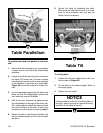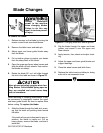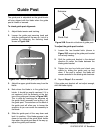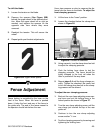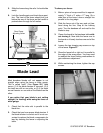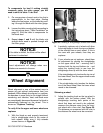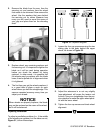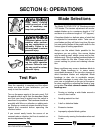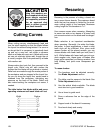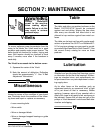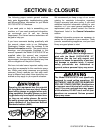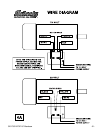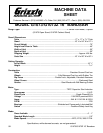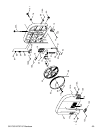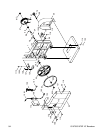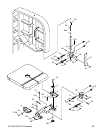
-28- G1073/G1073Z 16" Bandsaw
Cutting Curves
When cutting curves, simultaneously feed and
turn the stock carefully so that the blade follows
the layout line without being twisted. If a curve is
so abrupt that it is necessary to repeatedly back
up and cut a new kerf, use either a narrower
blade or a blade with more set. A blade with more
set can cut relatively tighter radii, though the cut
is usually rougher than cuts produced by a blade
with medium set.
Always make short cuts first, then proceed to the
longer cuts. Relief cuts will also reduce the
chance that the blade will be pinched or twisted.
Relief cuts are made through the waste portion of
the workpiece and are stopped at the layout line.
As you cut along the layout line, waste wood is
released from the workpiece, alleviating any
pressure on the back of the blade. Relief cuts
also make backing the workpiece out easier, if
needed.
The table below lists blade widths and corre-
sponding minimum radii each blade will cut:
Width Radius
1
⁄8''................................
3
⁄16''
3
⁄16'' ..............................
5
⁄16''
1
⁄4''................................
5
⁄8''
3
⁄8''................................1
1
⁄2''
1
⁄2''................................2
1
⁄2''
5
⁄8''................................4''
3
⁄4''................................5
1
⁄2''
Resawing
Resawing is the process of cutting a board into
two or more thinner boards. The maximum board
width that can be resawn is limited by the maxi-
mum cutting height of the bandsaw. Maximum
cutting height for this bandsaw is 7
3
⁄4''.
Use common sense when resawing. Attempting
to resaw too wide or too dense of a board may
put excessive strain on the blade and be danger-
ous.
Blade selection is an important consideration
when resawing. Generally, the wider the blade,
the better. In most applications, a hook or skip
tooth style will be sufficient. Also, since most
resawn lumber will be planed smooth, you can
choose blades with fewer teeth per inch (from 3
to 6). While blades with fewer teeth per inch pro-
duce rougher cuts, these types of blades offer
larger gullet capacities for clearing sawdust, less
heat buildup, and yield more horsepower per
tooth.
To resaw lumber:
1. The bandsaw must be adjusted correctly.
See Blade Adjustment section.
2. The table must be square to the blade. See
Table Adjustment section.
3. Use the widest blade available. The blade
must also be in good condition.
4. Use a fence to guide work.
5. Draw a reference line on the edge of the
board.
6. Support ends of the board if necessary.
7. Feed work slowly and evenly.
Using this machine pro-
duces sawdust which may
cause allergic reactions
and respiratory problems.
Use an approved dust
mask to protect yourself
from these hazards!



